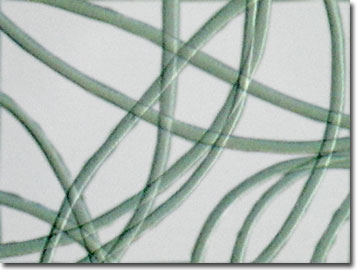Oblique Digital Image Gallery
Merino Wool
When the question was asked of the little black sheep if it had any wool, the reply was: "three bags full". The better question may have been was it merino wool. Because of its superior shine and legendary softness, handmade rugs and fine garments woven with merino wool command the highest prices. With the average adult sheep providing about seven pounds of raw wool, a herd of 300 may yield nearly a ton of wool each year. Wool fiber has a natural stretch and elasticity that responds to the wearer's body movements.

For thousands of years, wool has been used for clothing and other textiles. Named for the merino sheep that originated from a Greek colony in southeastern Italy, the Iberian Peninsula boasted the best herds and the largest wool production by the early eighteenth century. After hundreds of years of selective breeding, merino wool has a higher level of built-in ultraviolet light protection than many other fibers. From the original Italian and Spanish breeds, there are now more than ten varieties grown worldwide, each with its special properties for wool fiber and meat production.
Wool fibers have minute overlapping scales or plates, all aligned in one direction, just as the tiles on a roof. Under pressure, heat, and moisture, these fibers interlock into felt. In one inch of wool fiber there may be 2,000 overlapping shingles, adding strength but maintaining flexibility for wool products. Not only the breed, but the climate and quality of the pastures affect the quality of the wool fiber. The best merino wool comes from regions that are not tainted with pollutants and feature high mountains such as Kashmir or New Zealand. In these pastures, the sheep produce wool with large quantities of lanoline and a naturally silky luster that helps protect against moth damage. In some cases, merino wool is blended with lesser quality fibers from other varieties of sheep or animals such as llamas, rabbits, or goats before weaving. Unlike some synthetic fibers, merino wool fiber clothing not only can wick away moisture from a sweating body, it can also absorb odors. An unusual use for merino wool is the manufacturing of fine concert piano hammers such as the Steinways.
Contributing Authors
Cynthia D. Kelly, Thomas J. Fellers and Michael W. Davidson - National High Magnetic Field Laboratory, 1800 East Paul Dirac Dr., The Florida State University, Tallahassee, Florida, 32310.
BACK TO THE OBLIQUE IMAGE GALLERY
BACK TO THE DIGITAL IMAGE GALLERIES
Questions or comments? Send us an email.
© 1995-2025 by Michael W. Davidson and The Florida State University. All Rights Reserved. No images, graphics, software, scripts, or applets may be reproduced or used in any manner without permission from the copyright holders. Use of this website means you agree to all of the Legal Terms and Conditions set forth by the owners.
This website is maintained by our
Graphics & Web Programming Team
in collaboration with Optical Microscopy at the
National High Magnetic Field Laboratory.
Last Modification Friday, Nov 13, 2015 at 01:19 PM
Access Count Since September 17, 2002: 17312
Visit the website of our partner in introductory microscopy education:
|
|
